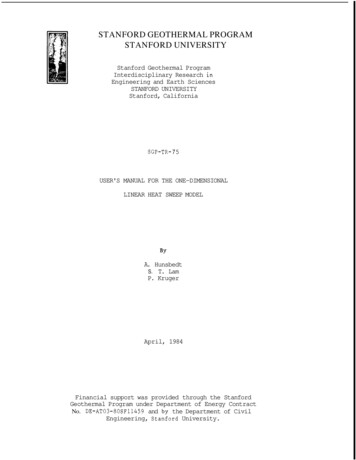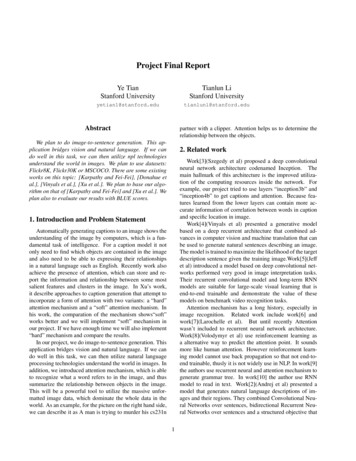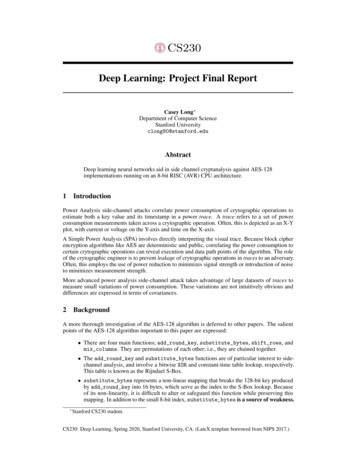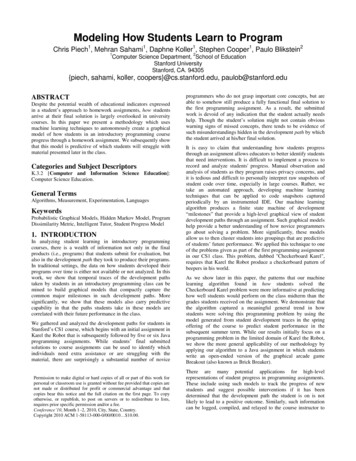
Transcription
CS110 Lecture 11: Signals, Part 2CS110: Principles of Computer SystemsWinter 2021-2022Stanford UniversityInstructors: Nick Troccoli and Jerry CainPDF of this presentation1
CS110 Topic 2: How can our programcreate and interact with other programs?2
Learning About ProcessesCreatingprocesses andrunning otherprogramsInter-processcommunicationand PipesSignalsVirtual gn3: implement multiprocessing programs like "trace" (to trace anotherprogram's behavior) and "farm" (parallelize tasks)assign4: implement your own shell!3
Learning GoalsLearn about how to handle SIGCHLD signals to clean up child processesGet practice writing signal handlersSee the challenges and pitfalls of signal handlersLearn how to temporarily ignore signals with sigprocmask and wait for signals withsigwait4
Plan For TodayRecap: Signals so farSIGCHLD HandlersDemo: Return Trip To DisneylandConcurrency ChallengesWaiting for Signals with sigwait and sigprocmask5
Plan For TodayRecap: Signals so farSIGCHLD HandlersDemo: Return Trip To DisneylandConcurrency ChallengesWaiting for Signals with sigwait and sigprocmask6
SignalsA signal is a way to notify a process that an event has occurredThere is a list of defined signals that can be sent (or you can define your own): SIGINT,SIGSTOP, SIGKILL, SIGCONT, etc.A signal is really a number (e.g. SIGSEGV is 11)A program can have a function executed when a type of signal is receivedSignals are sent either by the operating system, or by another processe.g. SIGCHLD sent by OS to parent when child changes stateYou can send a signal to yourself or to another process you own7
SignalsSome common signals (some 30 types are supported on Linux systems):8
Sending SignalsThe operating system sends many signals, but we can also send signals manually.int kill(pid t pid, int signum);// same as kill(getpid(), signum)int raise(int signum);kill sends the specified signal to the specified process (poorly-named; previously,default for most signals was to just terminate target process)pid parameter can be 0 (specify single pid), -1 (specify process group abs(pid)), or0/-1 (we ignore these).raise sends the specified signal to yourself9
waitpid()Waitpid can be used to wait on children to terminate or change state:pid t waitpid(pid t pid, int *status, int options);pid: the PID of the child to wait on, or -1 to wait on any of our childrenstatus: where to put info about the child's status (or NULL)the return value is the PID of the child that was waited on, -1 on error, or 0 if there areother children to wait for, but we are not blocking.The default behavior is to wait for the specified child process to exit. options lets uscustomize this further (can combine these flags using ):WUNTRACED - also wait on a child to be stoppedWCONTINUED - also wait on a child to be continuedWNOHANG - don't block10
Signal HandlersWe can have a function of our choice execute when a certain signal is received.We must register this "signal handler" with the operating system, and then it will becalled for us.typedef void (*sighandler t)(int);.sighandler t signal(int signum, sighandler t handler);signum is the signal (e.g. SIGCHLD) we are interested in.handler is a function pointer for the function to call when this signal is received.(Note: no handlers allowed for SIGSTOP or SIGKILL)11
Signal HandlersA signal can be received at any time, and a signal handler can execute at any time.Signals aren't always handled immediately (there can be delays)Signal handlers can execute at any point during the program execution (eg. pausemain() execution, execute handler, resume main() execution)Goal: keep signal handlers simple!12
Signal HandlersSignals like SIGSEGV and SIGFPE are called "traps" and are typically sent if there was aproblem with the program. Their signal handlers are called immediately, within the sametime slice, after the offending instruction is executed.Signals like SIGCHLD and SIGINT are called "interrupts" and are typically sent becausesomething external to the process occurred. Their signal handlers may not be calledimmediately:Generally invoked at the beginning of the recipient's next time slice.If the recipient is on the CPU when the signal arrives, it can be executed immediately,but it's typically deferred until its next time slice begins.Programs can rarely recover from traps, though may be able to recover from interrupts.That's why the default handler for most traps is to terminate the process and the defaulthandler for most interrupts is something else.13
Plan For TodayRecap: Signals so farSIGCHLD HandlersDemo: Return Trip To DisneylandConcurrency ChallengesWaiting for Signals with sigwait and sigprocmask14
SIGCHLDKey insight: when a child changes state, the kernel sends a SIGCHLD signal to its parent.This allows the parent to be notified its child has e.g. terminated while doing otherworkwe can add a SIGCHLD handler to clean up children without waiting on them in theparent!15
SIGCHLD Example: 52627static const size t kNumChildren 5;static size t numChildrenDonePlaying 0;static void reapChild(int sig) {waitpid(-1, NULL, 0);numChildrenDonePlaying ;}int main(int argc, char *argv[]) {printf("Let my five children play while I take a nap.\n");signal(SIGCHLD, reapChild);for (size t kid 1; kid kNumChildren; kid ) {if (fork() 0) {sleep(3 * kid); // sleep emulates "play" timeprintf("Child #%zu tired. returns to parent.\n", kid);return 0;}}while (numChildrenDonePlaying kNumChildren) {printf("At least one child still playing, so parent nods off.\n")snooze(5); // custom fn to sleep uninterruptedprintf("Parent wakes up! ");}printf("All children accounted for. Good job, parent!\n");return 0;}16
SIGCHLD Example: 52627static const size t kNumChildren 5;static size t numChildrenDonePlaying 0;static void reapChild(int sig) {waitpid(-1, NULL, 0);numChildrenDonePlaying ;}What happens if all children sleepfor the same amount of time? (E.g.change line 15 from sleep(3 * kid) tosleep(3)).int main(int argc, char *argv[]) {printf("Let my five children play while I take a nap.\n");signal(SIGCHLD, reapChild);for (size t kid 1; kid kNumChildren; kid ) {if (fork() 0) {sleep(3); // sleep emulates "play" timeprintf("Child #%zu tired. returns to parent.\n", kid);return 0;}}while (numChildrenDonePlaying kNumChildren) {printf("At least one child still playing, so parent nods off.\n")snooze(5); // custom fn to sleep uninterruptedprintf("Parent wakes up! ");}printf("All children accounted for. Good job, parent!\n");return 0;}17
Signal HandlersProblem: a signal handler is called if one or more signals are sent.Like a notification that "one or more signals are waiting for you!"The kernel tracks only what signals should be sent to you, not how manyWhen we are sleeping, multiple children could terminate, but result in 1 handler call!Solution: signal handler should clean up as many children as possible.18
SIGCHLD Signal Handlers1 static void reapChild(int sig) {waitpid(-1, NULL, 0);2numChildrenDonePlaying ;34 }Let's add a loop to reap as many children aspossible.19
SIGCHLD Signal Handlers1 static void reapChild(int sig) {while (true) {2pid t pid waitpid(-1, NULL, 0);3if (pid 0) break;4numChildrenDonePlaying ;5}67 }Let's add a loop to reap as many children aspossible.Question: what does the waitpid loop do ifone child terminates but other children arestill running?Problem: this may block if other childrenare taking longer! We only want to cleanup children that are done now. Others willsignal later. (DEMO)20
SIGCHLD Signal Handlers1 static void reapChild(int sig) {while (true) {2pid t pid waitpid(-1, NULL, WNOHANG);3if (pid 0) break;4numChildrenDonePlaying ;5}67 }Let's add a loop to reap as many children aspossible.Solution: use WNOHANG, which meansdon't block. If there are children we wouldhave waited on but aren't, returns 0. -1typically means no children left.Note: the kernel blocks additional signalsof that type while a signal handler isrunning (they are sent later).21
Plan For TodayRecap: Signals so farSIGCHLD HandlersDemo: Return Trip To DisneylandConcurrency ChallengesWaiting for Signals with sigwait and sigprocmask22
Demo: five-children.cfive-children-soln.c23
Plan For TodayRecap: Signals so farSIGCHLD HandlersDemo: Return Trip To DisneylandConcurrency ChallengesWaiting for Signals with sigwait and sigprocmask24
ConcurrencyConcurrency means performing multiple actions at the same time.Concurrency is extremely powerful: it can make your systems faster, more responsive,and more efficient. It's fundamental to all modern software.When you introduce multiprocessing (e.g. fork) and asynchronous signal handling(e.g. signal), it's possible to have concurrency issues. These are tricky!Most challenges come with shared data - e.g. two routines using the same variable.Many large systems parallelize computations by trying to eliminate shared data - e.g.split the data into independent chunks and process in parallel.A race condition is an unpredictable ordering of events (due to e.g. OS scheduling)where some orderings may cause undesired behavior.25
Off To The RacesConsider the following program, job-list-broken.c:The program spawns off three child processes at one-second intervals.Each child process prints the date and time it was spawned.The parent maintains a pretend job list (doesn't actually maintain a data structure, justprints where operations would have been performed).26
Off To The Races1234567891011121314151617181920// job-list-broken.cstatic void reapProcesses(int sig) {while (true) {pid t pid waitpid(-1, NULL, WNOHANG);if (pid 0) break;printf("Job %d removed from job list.\n", pid);}}char * const kArguments[] {"date", NULL};int main(int argc, char *argv[]) {signal(SIGCHLD, reapProcesses);for (size t i 0; i 3; i ) {pid t pid fork();if (pid 0) execvp(kArguments[0], kArguments);sleep(1); // force parent off CPUprintf("Job %d added to job list.\n", pid);}return 0;}myth60 ./job-list-brokenSun Jan 27 03:57:30 PDT 2019Job 27981 removed from job list.Job 27981 added to job list.Sun Jan 27 03:57:31 PDT 2019Job 27982 removed from job list.Job 27982 added to job list.Sun Jan 27 03:57:32 PDT 2019Job 27985 removed from job list.Job 27985 added to job list.myth60 ./job-list-brokenSun Jan 27 03:59:33 PDT 2019Job 28380 removed from job list.Job 28380 added to job list.Sun Jan 27 03:59:34 PDT 2019Job 28381 removed from job list.Job 28381 added to job list.Sun Jan 27 03:59:35 PDT 2019Job 28382 removed from job list.Job 28382 added to job list.myth60 Symptom: it looks like jobs are being removed from the list before beingadded! How is this possible?27
Off To The Races1234567891011121314151617181920// job-list-broken.cstatic void reapProcesses(int sig) {while (true) {pid t pid waitpid(-1, NULL, WNOHANG);if (pid 0) break;printf("Job %d removed from job list.\n", pid);}}char * const kArguments[] {"date", NULL};int main(int argc, char *argv[]) {signal(SIGCHLD, reapProcesses);for (size t i 0; i 3; i ) {pid t pid fork();if (pid 0) execvp(kArguments[0], kArguments);sleep(1); // force parent off CPUprintf("Job %d added to job list.\n", pid);}return 0;}Cause: there is a race condition with thesignal handler. It is possible for thechild to execute and terminate beforethe parent adds the job to the job list.Therefore, the signal handler will becalled to remove the job before theparent adds the job!28
Signal Handler ChallengesSignal handlers can interrupt execution at unpredictable timesThere are ways to guard against this, but it adds a lot of complexity.Also, ideally we rely only on signal-handler-safe functions in signal handlers, but mostof them are system calls. E.g. no printf!Signal handlers are difficult to use properly, and the consequences can be severe.Many regard signals to be one of the worst parts of Unix’s design.This installment of Ghosts of Unix Past explains why asynchronous signal handlingcan be such a headache. Main point: can be executed at bad times (while the mainexecution flow is in the middle of a malloc call, or accessing a complex datastructure).29
Let's learn about another way to handlesignals by waiting for them in ourprogram instead of using signal handlers.30
Plan For TodayRecap: Signals so farSIGCHLD HandlersDemo: Return Trip To DisneylandConcurrency ChallengesWaiting for Signals with sigwait and sigprocmask31
Waiting For SignalsSignal handlers allow us to do other work and be notified when signals arrive. But thismeans the notification is unpredictable.A more predictable approach would be to designate times in our program where westop doing other work and handle any pending signals.benefits: this allows us to control when signals are handled, avoiding concurrencyissuesdrawbacks: signals may not be handled as promptly, and our process blocks whilewaitingWe will not have signal handlers; instead we will have code in our main execution thathandles pending signals.32
Waiting For SignalsWe will designate times in our program where we stop doing other work and handle anypending signals.1. we need a way to handle pending signals2. we need a way to turn on "do not disturb" for signals when we do not wish to handlethem33
Waiting For SignalsWe will designate times in our program where we stop doing other work and handle anypending signals.1. we need a way to handle pending signals2. we need a way to turn on "do not disturb" for signals when we do not wish to handlethem34
sigwait()sigwait() can be used to wait (block) on a signal to come in:int sigwait(const sigset t *set, int *sig);set: the location of the set of signals to wait onsig: the location where it should store the number of the signal receivedthe return value is 0 on success, or 0 on error.Cannot wait on SIGKILL or SIGSTOP, nor synchronous signals like SIGSEGV or SIGFPE.35
Signal Setssigset t is a special type (usually a 32-bit int) used as a bit vector. It must be created andinitialized using special functions (we generally ignore the return values).// Initialize to the empty set of signalsint sigemptyset(sigset t *set);// Set to contain all signalsint sigfillset(sigset t *set);// Create a set of SIGINT and SIGTSTPsigset t gaddset(&monitoredSignals, SIGINT);sigaddset(&monitoredSignals, SIGTSTP);// Add the specified signalint sigaddset(sigset t *set, int signum);// Remove the specified signalint sigdelset(sigset t *set, int signum);36
sigwait()Here's a program that overrides the behavior for Ctl-z to print a message instead:1 int main(int argc, char *argv[]) {2sigset t sigaddset(&monitoredSignals, SIGTSTP);56printf("Just try to Ctl-z me!\n");7while (true) {8int delivered;9sigwait(&monitoredSignals, &delivered);10printf("\nReceived signal %d: %s\n", delivered, strsignal(delivered));11}1213return 0;14 }sigwait.c37
sigwait()Problem: what if the user hits Ctl-z before we reach line 9, or between sigwait calls? It won'tbe handled by our code!1 int main(int argc, char *argv[]) {sigset t sigaddset(&monitoredSignals, SIGTSTP);45printf("Just try to Ctl-z me!\n");6while (true) {7int delivered;8sigwait(&monitoredSignals, &delivered);9printf("\nReceived signal %d: %s\n", delivered, strsignal(delivered));10}1112return 0;1314 }sigwait.c38
sigwait()Problem: what if the user hits Ctl-z before we reach line 9, or between sigwait calls? It won'tbe handled by our code!1 int main(int argc, char *argv[]) {2sigset t sigaddset(&monitoredSignals, SIGTSTP);sleep(2);567printf("Just try to Ctl-z me!\n");8while (true) {9int delivered;10sigwait(&monitoredSignals, &delivered);11printf("\nReceived signal %d: %s\n", delivered, strsignal(delivered));sleep(2);1213}1415return 0;16 }sigwait.c39
This is a race condition: an unpredictableordering of events where some orderingsmay cause undesired behavior.40
Waiting For SignalsWe will designate times in our program where we stop doing other work and handle anypending signals.1. we need a way to handle pending signals2. we need a way to turn on "do not disturb" for signals when we do not wish to handlethem41
Do Not DisturbThe sigprocmask function lets us temporarily block signals of the specified types. Instead,they will be queued up and delivered when the block is removed.int sigprocmask(int how, const sigset t *set, sigset t *oldset);how is SIG BLOCK (add this to the list of signals to block), SIG UNBLOCK (removethis from the list of signals to block) or SIG SETMASK (make this the list of signals toblock)set is a special type that specifies the signals to add/remove/replace witholdset is the location of where to store the previous blocked set that we areoverwriting.Side note: forked children inherit blocked signals! We may wish to remove a block in thechild.42
Do Not DisturbHere's the same program from before, but blocking SIGTSTP as soon as possible:1 int main(int argc, char *argv[]) {2sigset t sigaddset(&monitoredSignals, SIGTSTP);sigprocmask(SIG BLOCK, &monitoredSignals, NULL);567printf("Just try to Ctl-z me!\n");8while (true) {9int delivered;10sigwait(&monitoredSignals, &delivered);11printf("\nReceived signal %d: %s\n", delivered, strsignal(delivered));12}1314return 0;15 }Wait - if we call sigwait while signals are blocked, what happens?Key insight: sigwait() doesn't care about blocked signals when it is called.sigwait.c43
RecapRecap: Signals so farSIGCHLD HandlersDemo: Return Trip To DisneylandConcurrency ChallengesWaiting for Signals with sigwait and sigprocmaskNext time: multiprocessing wrap-up and virtual memory44
CS110 Lecture 11: Signals, Part 2 CS110: Principles of Computer Systems Winter 2021-2022 Stanford University Instructors : Nick Troccoli and Jerry Cain PDF of this presentation 1. . Demo: Return Trip To Disneyland Concurrency Challenges Waiting for Signals with sigwait and sigprocmask 5. Plan For Today










